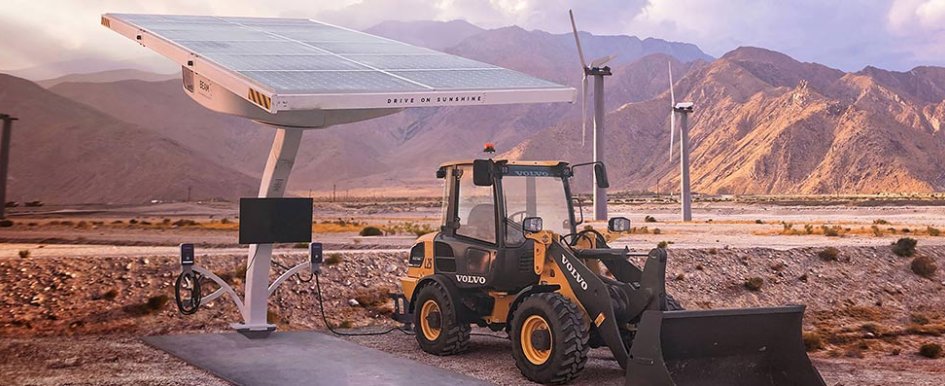
Electric construction equipment is quickly gaining ground. From compact excavators to full-size wheel loaders, electric machines are proving they can match — or outperform — their diesel counterparts, all while reducing emissions and noise.
But a key question remains: What’s the cleanest, most cost-effective way to charge them?
Many jobsites rely on diesel generators or nonrenewable grid power, limiting the environmental and financial upsides of electrifying a fleet. That’s where charging options that incorporate renewable energy come in.
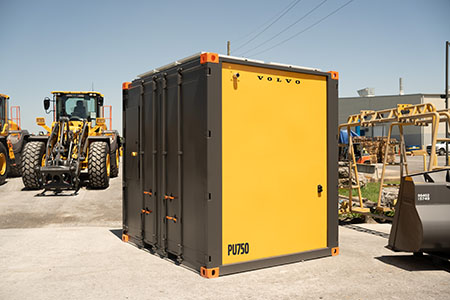
Where Things Stand Today
Some contractors are considering, or have already made, an investment in electric machines. But unless the power source for those machines is equally forward-thinking, they’re only getting part of the benefit.
There’s a growing selection of charging systems that use solar or wind power or can be charged on the grid and then taken to a jobsite. This allows contractors to work cleaner, lower their fuel costs and reduce dependence on utility infrastructure — while also preparing for evolving regulatory demands.
Future-focused contractors are piloting systems that generate and store renewable power on-site. It’s a long-term strategy that protects against price volatility, avoids peak energy pricing and better aligns with a net-zero future.
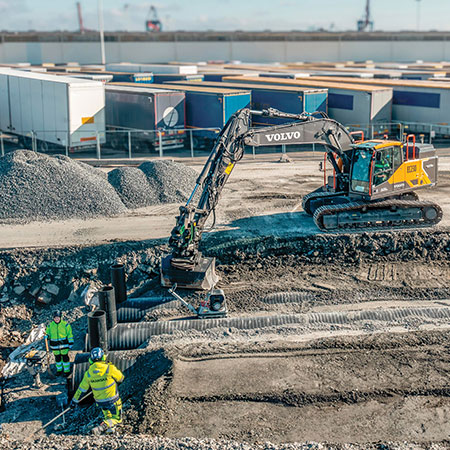
What It Means for Your Bottom Line
Setting up on-site renewable energy infrastructure involves an investment — but one that can offer significant returns, especially on long-term or remote projects.
Key benefits include the following:
- Fuel savings — Solar and wind generation and rechargeable power banks reduce or eliminate diesel purchases.
- Reduced downtime — On-site energy keeps machines working without waiting on fuel trucks, generator set (genset) logistics or utility scheduling.
- Cleaner jobsites — Lower emissions meet sustainability goals and can be a competitive advantage.
- Improved public relations — Clients increasingly want to know how a project impacts the environment. Running on renewables is a story worth sharing.
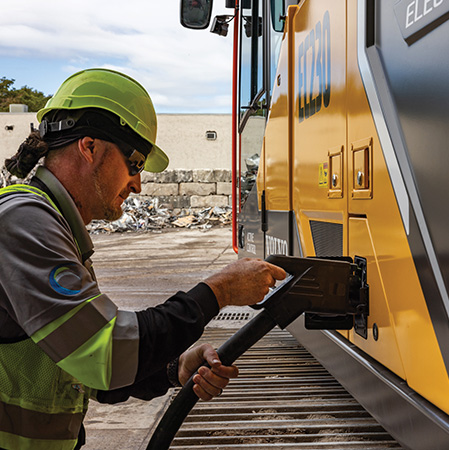
Ways to Get Started
There are three main options for on-site renewable energy:
1. On-Site Generation
Solar power is a great choice thanks to its scalability and falling costs. It can be deployed via trailers, foldout panels on shipping containers or fixed ground arrays. In some cases, small wind turbines or biodiesel-powered backup generators are used to supplement solar output.
One example of a solar-powered charger is the EV ARC from Beam. It’s easy to transport and set up and doesn’t require a grid connection.
2. Energy Storage
A battery energy storage system (BESS) can capture excess generation and is great for charging during peak hours or overnight. A BESS is an assembly of multiple battery packs to create one high-capacity system, meaning it can be sized to your exact needs. Some manufacturers offer portable containerized storage solutions designed specifically for construction environments and charging duties.
3. Charging Infrastructure
At this early stage in heavy equipment electrification, fast chargers or Level 2 chargers are required to keep larger machines operational throughout the workday.
Some units can be transported to and from a jobsite via trailer or truck. They can also include smart charging functionality, which digitally connects assets to optimize energy consumption and costs by scheduling charging times.
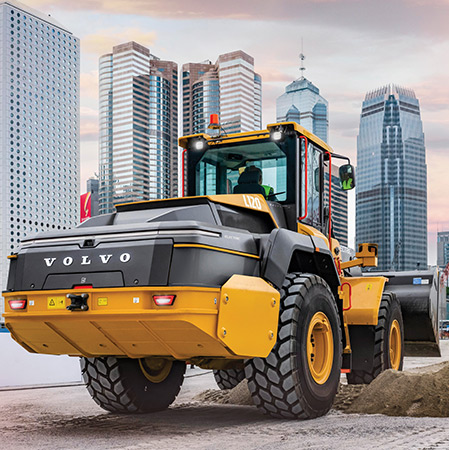
A Real-World Example
One interesting test of the viability of fossil-free jobsites has been happening in Stockholm, Sweden — but its findings will undoubtedly impact strategies worldwide.
An industrial area is being fully redeveloped, incorporating the city’s goal to be climate positive by 2030 and fossil-fuel-free by 2040. The first phase of the project, which recently concluded, achieved carbon dioxide (CO2) savings of more than 2,759 tons — that’s roughly equivalent to the annual emissions of more than 5,000 gasoline cars.
For the second phase, the city declared carbon reduction targets at the bid stage, setting a new standard for accountability. The goal is to reduce emissions even further by coming in under 3.5 tons of CO2 per $103,500 budgeted. This is a decline from the typical 11 to 29 tons emitted in similar projects.
Construction giant Skanska secured the contract by illustrating their own sustainability results in a proposal that aligned with Stockholm’s goals. They’re getting it done with two electric trucks with trailers, an electric-powered sorting tool, an electric compaction tool, two Volvo CE 23-ton EC230 Electric crawler excavators and one 22-ton L120H wheel loader converted to electric, and other hand-operated electric machines. Charging infrastructure includes two portable fast chargers and three battery packs.
Skanska is working toward a fossil-free site by using hydrogenated vegetable oil (HVO) fuel in internal combustion machines and increasing their use of electric equipment from 10% to 50%. The company will also use climate-reduced concrete.
Not only will these efforts help Stockholm meet its target and enhance air quality, but they will also greatly reduce noise levels in the busy city center. Depending on the machine, electric models can be up to 75% quieter than their diesel equivalents.
Skanska’s project manager, Anna Göransdotter, says the city’s prioritization of emission reduction sets a precedent and drives innovation across the construction industry.
“This proactive approach creates a ripple effect throughout the entire value chain, pushing all stakeholders to explore new possibilities and expand the boundaries of what can be achieved in sustainable construction,” she said.
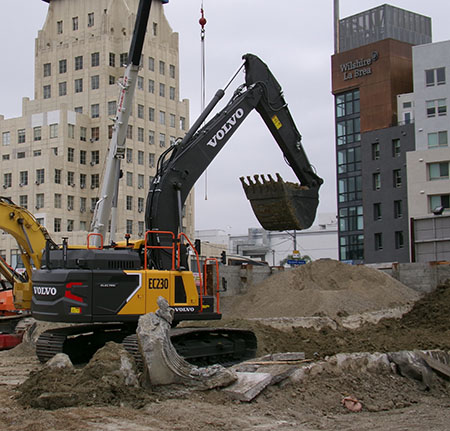
Challenges to Keep in Mind
While this approach is gaining traction, it’s not plug-and-play just yet. A few challenges that will be ironed out in the coming months and years include the following:
- Cost of entry — Mobile solar units and energy storage systems require up-front capital. However, incentives and tax credits may be available depending on your location.
- Space requirements — Solar panels and BESS units take up real estate that is often limited on cramped jobsites.
- Energy planning — You’ll need to understand your equipment’s total daily load and plan for energy demand across different phases of the job.
The good news? This is where original equipment manufacturers (OEMs), energy consultants and project engineers can — and must — collaborate. Pre-job planning for renewables can be integrated into your overall construction timeline, just like stormwater management or site access.
Speaking on behalf of an OEM, I consider it our job (and privilege) to listen and be consultative as we help companies determine how to incorporate electric equipment into their fleets. It’s not just about a machine and a charger. Understanding their business and specific projects is the only way for this kind of integration to succeed.
What’s Next for Contractors & OEMs
The days of viewing energy supply as someone else’s problem are over. As jobsites get smarter and machines get cleaner, energy sourcing will become a critical part of your planning and your profit margin.
Some contractors are already seeing the payoff. Municipalities and private developers alike are prioritizing clean jobsites, and some jurisdictions are enforcing emissions caps on off-road machinery. If you’re bidding on work that has (or may have in the future) low- or no-emission or noise requirements, having a plan to integrate renewables can give you an edge.
Companies at all stages of the value chain are increasingly collaborating to decarbonize the entire process, from OEMs to charging solution developers to those who can improve and operate our grid to the contractors using the products. OEMs specifically are in a strong position to lead this shift — not just by selling electric equipment, but by helping customers create holistic energy strategies. It can’t be only on-road or off-road or building design. All these industries need to work together.
Fueling the Future
Electric machines offer quieter operation, zero emissions and around 35% lower lifetime maintenance costs. Plus, with diesel prices constantly fluctuating, electricity is a more stable, less expensive energy source.
Simply put: Electric is the future of construction. But to unlock its full value, the industry must think beyond machines and toward entire energy ecosystems. On-site renewable charging isn’t just a green ideal — it’s an operational strategy that smart contractors are already implementing.
Now is the time to build a plan, build a partnership and build smarter.
